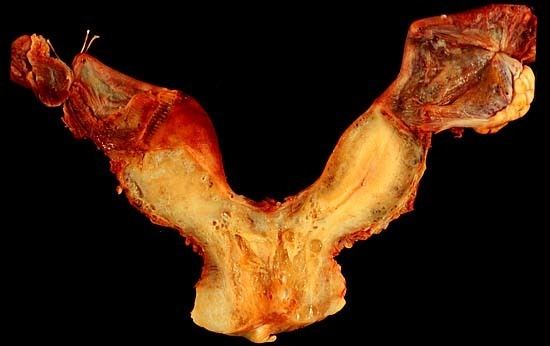Specialty medical genetics ICD-9-CM 752.2-752.3 | ICD-10 Q51 | |
 | ||
A uterine malformation is a type of female genital malformation resulting from an abnormal development of the Müllerian duct(s) during embryogenesis. Symptoms range from amenorrhea, infertility, recurrent pregnancy loss, and pain, to normal functioning depending on the nature of the defect.
Contents
Prevalence
The prevalence of uterine malformation is estimated to be 6.7% in the general population, slightly higher (7.3%) in the infertility population, and significantly higher in a population of women with a history of recurrent miscarriages (16%).
Types
The American Fertility Society (now American Society of Reproductive Medicine) Classification distinguishes:
A uterine septum can be corrected by hysteroscopic surgery.
An additional variation is the arcuate uterus where there is a concave dimple in the uterine fundus within the cavity.
A rudimentary uterus is a uterine remnant not connected to cervix and vagina and may be found on the other side of an unicornuate uterus.
Patients with uterine abnormalities may have associated renal abnormalities including unilateral renal agenesis.
"Double vagina"
As the vagina is largely derived from the Müllerian ducts, lack of fusion of the two ducts can lead to the formation of a vaginal duplication and lack of absorption of the wall between the two ducts will leave a residual septum, leading to a "double vagina". This condition may be associated with a uterus didelphys or a uterine septum. Since the condition is internal and usually asymptomatic, a person may not be aware of having a "double vagina." If necessary, the partition can be surgically corrected, however, there is no valid medical reason for such a procedure.
Diagnosis
Besides a physical examination, the physician will need imaging techniques to determine the character of the malformation: gynecologic ultrasonography, pelvic MRI, or hysterosalpingography. A hysterosalpingogram is not considered as useful due to the inability of the technique to evaluate the exterior contour of the uterus and distinguish between a bicornuate and septate uterus. In addition, laparoscopy and/or hysteroscopy may be indicated. In some patients the vaginal development may be affected.
Treatment
Surgical intervention depends on the extent of the individual problem. With a didelphic uterus surgery is not usually recommended. A uterine septum can be resected in a simple out-patient procedure that combines laparoscopy and hysteroscopy. This procedure greatly decreases the rate of miscarriage for women with this anomaly.
